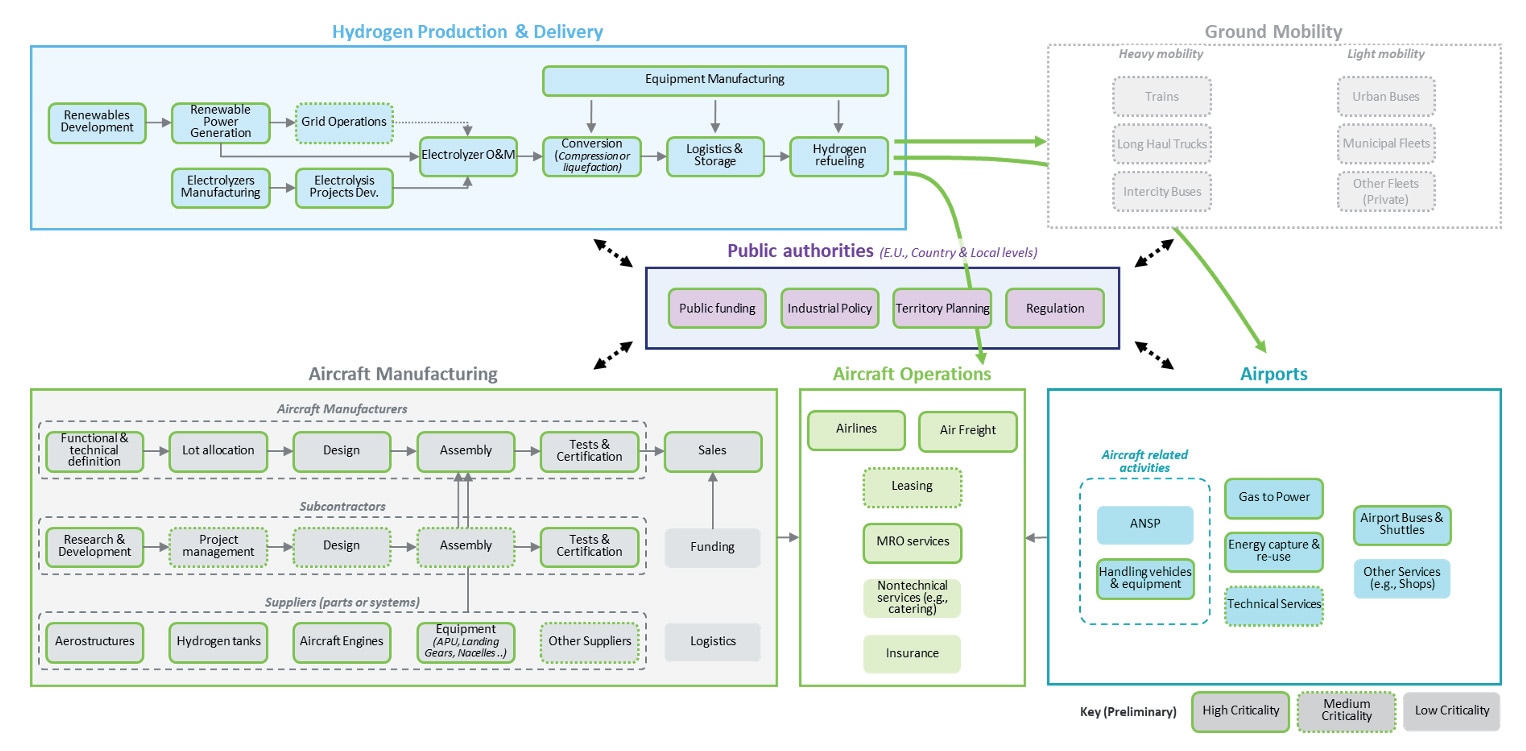Point de vue

Green Aviation
Reducing Emissions Along The Aircraft Value Chain
Globally, flights produced approx. 915 Mt of CO2 in 2019i (i.e., prior to COVID-19), 2.1% of global human CO2 emissions of 43 billion tonsii. Aviation was then responsible for 12% of CO2 emissions from all transport sources, compared to 74% for road transport. While the aviation industry is more fuel efficient (i.e., approx. 100 grams of CO2 per RPKiii, 70% more fuel efficient than 50 years ago), overall emissions have risen as the volume of air travel has increased. By 2020, aviation emissions were 70% higher than in 2005 and they could grow by 300% if nothing is done. Just 1 percent of global population is responsible for half the emissions caused by aviation.iv
Air transport industry has been ahead of the decarbonation curve for several years, committing to halve its CO2 emissions by 2050 (vs. 2005), in line with the Paris agreement objectives, and even to achieve carbon-neutrality for intra-European flights by this date.v
To achieve such an ambition, a holistic approach must be adopted, covering the whole aviation value chain, and involving a whole ecosystem, far beyond only aircraft operations and production.
Structural evolutions on aircraft and propulsion technology are the key lever to reduce GHG emissions:
- Fleet renewal is underway, as current technology aircrafts (e.g., A320Ceo, B737NG, A330, …) are being currently substituted by new ones (A320Neo, B737MAX, A350, B787). They leverage advanced alloys (Ti, Al/Li), composite structures, optimized design (e.g., winglets – which retrofitting on aircrafts has meant 80 million tons of CO2 avoided since 2000) and higher efficiency engines (e.g., Leap, …) to deliver sizeable fuel savings of 15 to 20%.vi.
- Sustainable alternative fuels (SAF), either bio-sourced (i.e., produced from plants such as Camelina, Jatropha, Babassu, Palm Oil) or obtained by combining green hydrogen with CO2 from CCS (Fischer Tropsch process) appear as a promising option, as they do not require aircraft design evolutions and are compatible with current engines. Depending on feedstock, CO2 emissions reductions amount between 50 et 98%vii, and promising achievements have been performed recently, as 45 airlines globally now have an experience with SAF. However, SAF consumption is still modest, with approx. 100M liters in 2021viii (i.e., 0.1% of global jet fuel consumption). SAF cost historically 2 to 4 times as much as jet fuel, but recent steep increase in oil & gas price significantly reduced the gap (approx. x 1.5 – x 2)ix.
- Hydrogen-powered aircrafts are expected to come-in by the next decade. In addition to nil CO2 emissions, they are also expected to have a superior performance in terms of NOx emissions and contrails effect generation, only yielding higher H2 O vapor emissions (x 2.5 vs. combustion engines). In a preliminary phase auxiliary system are expected to be electrified thanks to fuel cells – replacing APU (cabin and systems electric power, water and pressurized air management, anti-ice, but also electrical wheel drive…). Hydrogen-propulsion aircrafts are expected to enter in service by 2035, and Airbus proposed 3 concepts, 2 rather traditional “evolutionary” based on architectures inspired from ATR (100 passengers over 1800km) and A320 (120 – 200 passengers over 3500 km) aircrafts, and a more disruptive “revolutionary” flying wing.x
Airlines’ operations and maintenance optimization should also have a significant – however less structural – impact on aircrafts CO2 emissions:
- Better flights planning and “ecopiloting” measures include reducing cancelled flights disturbing overall planning, avoiding Quick Return Flights on technical alerts (incl. fuel tanks emptying) and improving routes (flightpath and altitude accuracy, landing configurations). SESAR (EU) or NextGen (US) traffic management systems recast programs will enable these transformations.
- In-flight weight reduction is also an important lever. Interior design (seats, equipment, galleys,) is being continuously improved, and airlines are deploying policies to adapt on-board paper (digitization of flight documentation and magazines) and water prescriptions to load factors and flights durations.
- Ground operations are also improved, going from single engine taxiing, use of electric (e.g., Taxibot) or hydrogen powered ground vehicles to APU/GPU usage substitution by FEGP or fuel cells.
- Improved MRO plays finally also a sizeable role in decarbonation, as planning enabled by AI and Big Data should allow better overhaul operations planning and therefore smarter engine performance restoration. Furthermore, some maintenance operations like engine or plane washing, so as shark-skin coating deployment can improve fuel consumption (e.g., c. 1% for sharkskin)xi.
Finally, we roughly estimate that aircrafts production and maintenance operations value chains emit approx. 40Mt of CO2 in 2021 (based on Airbusxii, Boeingxiii, and key MRO players Scope 1,2 and 3 “Purchased Goods and Services” reporting). Even if modest in comparison with flight emissions (approx. 4 - 5% of total), some decarbonation avenues should be activated:
- Aircraft manufacturers and MRO players already strongly engaged in their Scope 1 & 2 emissions reductions (accounting for approx. 10 – 15% of the total), working on engine testing carbon efficiency (incl. SAF integration), extended manufacturing and maintenance process electrification, power auto-production (deploying proprietary solar panels in industrial facilities), buildings and process energy efficiency and better control of fugitive F-gases emissions from HVAC systems.
- However, the major stake sits in optimizing the whole aircraft end-toend construction and maintenance process, starting at the design phase, and looking at the whole lifecycle. The integration of sustainable parts and components (incl. the shift towards the qualification of competitive PMA players for spare sparts), as well as an aggiornamento of parts “replacement vs. repair or refurbishment” policies in maintenance operations is key. Holistic trade-offs in purchasing are also important to get the best from value chains (e.g., locally, or remotely sourced bio hydraulic fluids). Fully digital management of operations and supply chains (e.g., leveraging digital twins) is expected to be therefore great enabler for this transformation.
Of course, as the decarbonation effort encompasses the whole value chain, we expect efforts and initiatives compartmentalized to specific players or value chain stages to end-up in failure. In contrast, achieving substantial results will require the constitution of wellcoordinated ecosystems involving aircraft manufacturers, airlines, MRO players, airports, but also power & gas utilities and public authorities, or even ground mobility operators.
Illustrative example: the (simplified) ecosystem necessary to enable hydrogen powered aircrafts

i https://www.eesi.org/papers/view/fact-sheet-the-growth-in-greenhouse-gas-emissions-from-commercial-aviation#:~:text=According%20to%20the%20International%20Council,30%20percent%20in%20six%20years.
ii https://essd.copernicus.org/articles/11/1783/2019/
iii https://www.icao.int/annual-report-2019/Pages/the-world-of-air-transport-in-2019.aspx
iv https://thehill.com/changing-america/sustainability/energy/526565-one-percent-of-people-cause-50-percent-of-airline/#:~:text=Sustainability%20Energy-,1%20percent%20of%20people%20cause%2050%20percent%20of%20airline%20emissions,So%20who%20are%20they%3F&text=Research%20shows%20the%20airline%20industry,50%20percent%20of%20airline%20emissions.
v https://www.iata.org/en/programs/environment/flynetzero/#:~:text=Zero%20by%202050-,Fly%20Net%20Zero%20is%20the%20commitment%20of%20airlines%20to%20achieve,from%20their%20operations%20by%202050.
vi https://aviationbenefits.org/case-studies/a320neo/#:~:text=The%20A320neo%20is%20projected%20to,below%20ICAO%20Chapter%2D4%20requirements.
vii https://www.frontiersin.org/articles/10.3389/fenrg.2020.00110/full
viii https://www.iata.org/en/programs/environment/sustainable-aviation-fuels/#tab-2
ix https://www.flyingmag.com/could-saf-be-a-cost-effective-solution-to-rising-aviation-fuel-prices/
x https://www.airbus.com/en/innovation/zero-emission/hydrogen/zeroe
xi https://www.lufthansa-technik.com/aeroshark
xii https://www.airbus.com/sites/g/files/jlcbta136/files/2022-04/Airbus%20SE%20Universal%20Registration%20Document%202021.pdf?202204
xiii https://s2.q4cdn.com/661678649/files/doc_financials/2020/sr/2020-Boeing-Environment-Report-Companion-Summary.pdf



